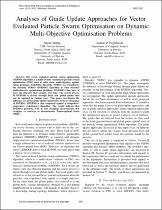 ResearchSpace
ResearchSpace
Analyses of guide update approaches for vector evaluated particle swarm optimisation on dynamic multi-objective optimisation problems
JavaScript is disabled for your browser. Some features of this site may not work without it.
- ResearchSpace
- →
- Research Publications/Outputs
- →
- Conference Publications
- →
- View Item
| dc.contributor.author |
Helbig, M

|
|
| dc.contributor.author |
Engelbrecht, AP

|
|
| dc.date.accessioned | 2012-10-25T13:52:42Z | |
| dc.date.available | 2012-10-25T13:52:42Z | |
| dc.date.issued | 2012-06 | |
| dc.identifier.citation | Helbig, M and Engelbrecht, AP. Analyses of guide update approaches for vector evaluated particle swarm optimisation on dynamic multi-objective optimisation problems. Proceedings of the IEEE World Congress on Computational Intelligence: IEEE Congress on Evolutionary Computation, Brisbane, Australia, 10-15 June 2012, pp. 2621-2628 | en_US |
| dc.identifier.isbn | 978-1-4673-1508-1 | |
| dc.identifier.isbn | 978-1-4673-1510-4 | |
| dc.identifier.uri | http://ieeexplore.ieee.org/xpl/articleDetails.jsp;jsessionid=LjpKQhMfQRKn3bpJhylQ67LN9JWBP7LlxxYwpyDtC0RpjWhw25n9!1072163391?arnumber=6252882&contentType=Conference+Publications | |
| dc.identifier.uri | http://hdl.handle.net/10204/6222 | |
| dc.description | U.S Government work not protected by U.S. copyright. Proceedings of the IEEE World Congress on Computational Intelligence: IEEE Congress on Evolutionary Computation, Brisbane, Australia, 10-15 June 2012, pp. 2621-2628 | en_US |
| dc.description.abstract | Dynamic multi-objective optimisation problems (DMOOPs) occur in many situations in the real world. These optimisation problems do not have a single goal to solve, but many goals that are in conflict with one another - improvement in one goal leads to deterioration of another. Therefore, when solving DMOOPs, an algorithm attempts to find the set of optimal solutions, referred to as the Pareto-optimal front (POF). Each DMOOP also has a number of boundary constraints that limits the search space. When the particles of a particle swarm optimisation (PSO) algorithm moves outside the search space, an approach should be followed to manage violation of the boundary constraints. This chapter investigates the effect of various approaches to manage boundary constraint violations on the performance of the Dynamic Vector Evaluated Particle Swarm Optimisation (DVEPSO) algorithm when solving DMOOPs. Furthermore, the performance of DVEPSO is compared against the performance of three other state-of-the-art dynamic multi-objective optimisation (DMOO) algorithms. | en_US |
| dc.language.iso | en | en_US |
| dc.publisher | IEEE | en_US |
| dc.relation.ispartofseries | Workflow;9691 | |
| dc.subject | Dynamic multi-objective optimisation problems | en_US |
| dc.subject | DMOOP's | en_US |
| dc.subject | Computational analysis | en_US |
| dc.subject | Pareto-optimal front | en_US |
| dc.subject | POF | en_US |
| dc.subject | Computational analysis | en_US |
| dc.subject | Boundary constraint management | en_US |
| dc.title | Analyses of guide update approaches for vector evaluated particle swarm optimisation on dynamic multi-objective optimisation problems | en_US |
| dc.type | Conference Presentation | en_US |
| dc.identifier.apacitation | Helbig, M., & Engelbrecht, A. (2012). Analyses of guide update approaches for vector evaluated particle swarm optimisation on dynamic multi-objective optimisation problems. IEEE. http://hdl.handle.net/10204/6222 | en_ZA |
| dc.identifier.chicagocitation | Helbig, M, and AP Engelbrecht. "Analyses of guide update approaches for vector evaluated particle swarm optimisation on dynamic multi-objective optimisation problems." (2012): http://hdl.handle.net/10204/6222 | en_ZA |
| dc.identifier.vancouvercitation | Helbig M, Engelbrecht A, Analyses of guide update approaches for vector evaluated particle swarm optimisation on dynamic multi-objective optimisation problems; IEEE; 2012. http://hdl.handle.net/10204/6222 . | en_ZA |
| dc.identifier.ris | TY - Conference Presentation AU - Helbig, M AU - Engelbrecht, AP AB - Dynamic multi-objective optimisation problems (DMOOPs) occur in many situations in the real world. These optimisation problems do not have a single goal to solve, but many goals that are in conflict with one another - improvement in one goal leads to deterioration of another. Therefore, when solving DMOOPs, an algorithm attempts to find the set of optimal solutions, referred to as the Pareto-optimal front (POF). Each DMOOP also has a number of boundary constraints that limits the search space. When the particles of a particle swarm optimisation (PSO) algorithm moves outside the search space, an approach should be followed to manage violation of the boundary constraints. This chapter investigates the effect of various approaches to manage boundary constraint violations on the performance of the Dynamic Vector Evaluated Particle Swarm Optimisation (DVEPSO) algorithm when solving DMOOPs. Furthermore, the performance of DVEPSO is compared against the performance of three other state-of-the-art dynamic multi-objective optimisation (DMOO) algorithms. DA - 2012-06 DB - ResearchSpace DP - CSIR KW - Dynamic multi-objective optimisation problems KW - DMOOP's KW - Computational analysis KW - Pareto-optimal front KW - POF KW - Computational analysis KW - Boundary constraint management LK - https://researchspace.csir.co.za PY - 2012 SM - 978-1-4673-1508-1 SM - 978-1-4673-1510-4 T1 - Analyses of guide update approaches for vector evaluated particle swarm optimisation on dynamic multi-objective optimisation problems TI - Analyses of guide update approaches for vector evaluated particle swarm optimisation on dynamic multi-objective optimisation problems UR - http://hdl.handle.net/10204/6222 ER - | en_ZA |





